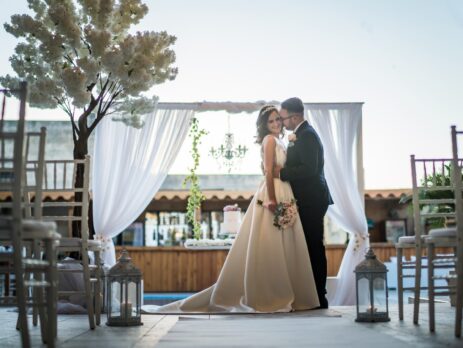Wedding ceremony layout tips for traditional and non-traditional seating
The standard ceremony seating layout—rows of chairs with an aisle down the middle—is always a safe bet. But if you’re considering an alternative setup, there are a few factors to keep in mind when choosing unique ways to seat guests at your wedding ceremony.
1. Make sure everyone has a clear view
In a traditional ceremony layout, guests face forward and understand where to look. Guests usually stagger themselves to make sure they can see the entire ceremony.
But with alternative layouts, you’ll have to walk through the space to make sure all of the seats have a clear view of the couple. Avoid placing chairs or benches where sightlines are unobstructed by architectural pillars, wedding arches, or large-scale floral arrangements.
2. Give the wedding party plenty of space
For larger wedding parties, consider where the group will stand. In tight circular or spiral layouts, there may not be room for larger wedding parties—and you don’t want bridesmaids hovering over seated guests. If the seating doesn’t allow space for the bridal party, reserve space for them to sit so the couple remains the central focus.
3. Avoid guest confusion with signage
Many couples are ditching the rules of “bride’s side” and “groom’s side” in favor of mixed seating. You’ll also need to keep the front rows clear for the wedding party and close family. Use ushers and signage to communicate exactly where guests can sit—and where they can’t.
4. Use space wisely for large guest lists
For a large wedding, plan a layout with the chairs positioned tightly together. More sprawling layouts—such as a single row spiral for 300 people—will take up entirely too much space. Plan unique layouts with comfort and space constraints in mind.
5. Set the scene for amazing photo ops
Many couples have an idea of the scene they’d like to set: Maybe they want the mountains or the ocean view in the background, for instance. Consider where the photographer will have the best setup to capture the ceremony with the stunning view in the background.
6. Ensure the vows are heard by all—even those in the back row
Guests enjoy hearing the ceremony and the vows. Consider the guests who are furthest from the action when arranging the seating. You may have to narrow the distance between seat rows (without causing a tight squeeze) to bring the back row closer, or consider an unobtrusive mic and speaker set up. Keep in mind: Ceremonies held outdoors are harder to hear than indoor events, and people with quiet voices may have difficulty projecting to the last row.
7. Ask the couple about their preferred processional length
If the couple doesn’t like all eyes on them, avoid a long walk past their guests before and after the ceremony. Make sure the aisle is a comfortable—not overwhelming—length. Similarly, don’t spoil the excitement of the walk down the aisle by cutting it too short or skipping it altogether.
8. Design for cultural or religious traditions when required
Plan for requirements for Christian, Jewish, Muslim, Orthodox, or other religious or cultural ceremony traditions. Couples may want to follow specific seating arrangements or customs for the ceremony—such as assigned sides based on whom the guests know, or men and women sitting separately—or create an interfaith wedding that blends traditions. Whether exchanging vows beneath a chuppah or Mandap or creating an arbor or arch with a personal touch, custom may be the starting point rather than the rule.
Creative Wedding Ceremony Seating & Layout Ideas | Social Tables


